Puckle gun - from Wikipedia
| The Puckle gun (also known as the Defence gun) was a
primitive crew-served, manually-operated flintlock revolver patented in
1718 by James Puckle (1667–1724) a British inventor, lawyer and writer.
It was one of the earliest weapons to be referred to as a "machine gun",
being called such in a 1722 shipping manifest, though its operation does
not match the modern use of the term. However, the Puckle gun was never
used during any combat operation or war. Production was highly limited
and may have been as few as two guns.
Design and Patent
The Puckle gun is a tripod-mounted, single-barreled flintlock
weapon fitted with a manually operated revolving cylinder; Puckle advertised
its main application as an anti-boarding gun for use on ships. The barrel
was 3 feet (0.91 m) long with a bore of 1.25 inches (32 mm). The cylinder
held 6 to 11 shots depending on configuration, and was hand-loaded with
powder and shot while detached from the weapon.
According to the Patent Office of the United Kingdom,
"In the reign of Queen Anne, the law officers of the Crown established
as a condition of grant that 'the patentee must by an instrument in writing
describe and ascertain the nature of the invention and the manner in which
it is to be performed.'" This gun's patent, number 418 of 1718, was one
of the first to provide such a description. T.W. Lee remarked, however,
that "James Puckle's patent in 1718 contains more rhetorical fervor than
technical rigor."
Two versions
Puckle demonstrated two configurations of the basic design:
one, intended for use against Christian enemies, fired conventional round
bullets, while the second, designed to be used against the Muslim Turks,
fired square bullets. The square bullets were considered to be more damaging.
They would, according to the patent, "convince the Turks of the benefits
of Christian civilization". The weapon was also reported as able to fire
shot, with each discharge containing sixteen musket balls.
Operation
The Puckle gun was fired in a similar fashion to a conventional
flintlock musket; however, after each shot, a crank on the threaded shaft
at the rear would be unscrewed to release the cylinder to turn freely.
The cylinder would then be advanced by hand to the next chamber, and the
crank turned back again to lock the cylinder into the breech of the fixed
barrel. The flintlock mechanism could then be primed for another shot:
it was triggered using a lever which was separate from the crank assembly.
To reload the weapon, the crank handle could be unscrewed
completely to remove the cylinder, which could then be replaced with a
fresh one. In this way it was similar to earlier breech-loading swivel
guns with a detachable chamber which could be loaded prior to use. The
cylinder appears to have been referred to as a "charger" in contemporary
documentation. |
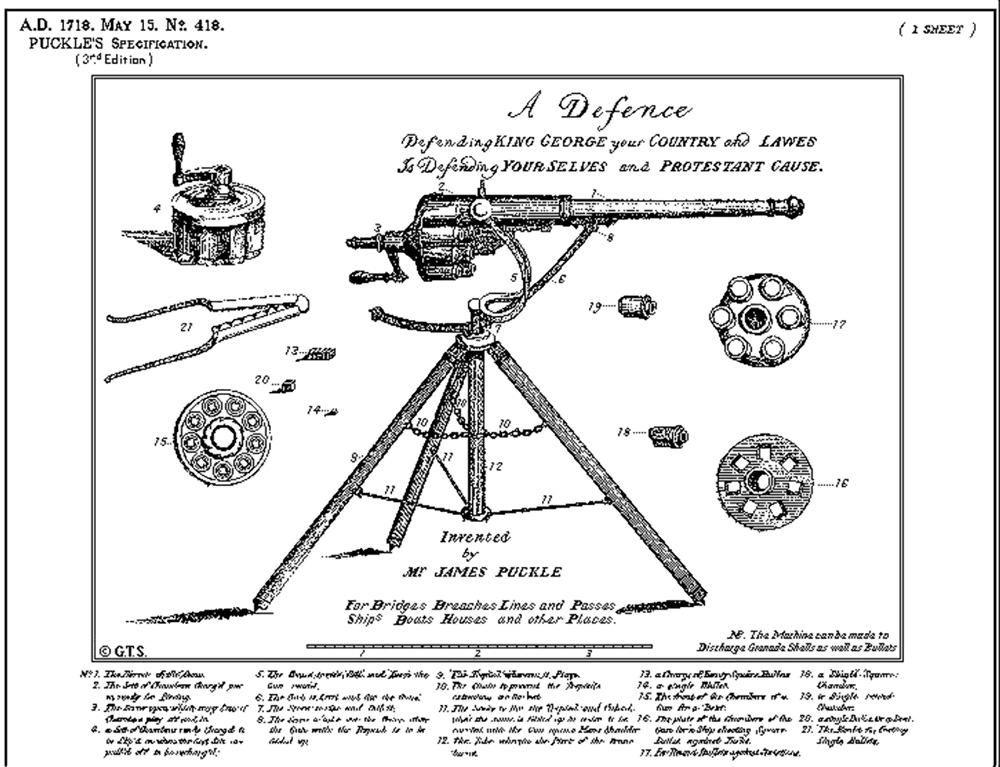
Patent #418, for James Puckle's 1718 revolving
firearm, showing various cylinders for
use with round and square bullets.
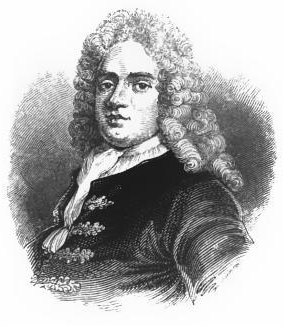
James Puckle (1667 - 1724),
English inventor, lawyer and writer,
patented in 1718 the Puckle gun.
|
Production and use
A prototype was shown in 1717 to the English Board of
Ordnance, who were not impressed. At a later public trial held in 1722,
a Puckle gun was able to fire 63 shots in seven minutes (approx 9 rounds
per minute) in the midst of a driving rain storm. A rate of 9 rounds per
minute compared favourably to musketeers of the period, who could be expected
to fire between 2 and 5 rounds per minute depending on the quality of the
troops, with experienced troops expected to reliably manage 3 rounds a
minute under fair conditions; it was however inferior in fire rate to earlier
repeating weapons such as the Kalthoff repeater which fired up to six times
faster.
The Puckle gun drew few investors and never achieved mass
production or sales to the British armed forces. As with other designs
of the time it was hampered by "clumsy and undependable flintlock ignition"
and other mechanical problems. A leaflet of the period sarcastically observed
of the venture that "they're only wounded who hold shares therein". Production
was highly limited and may have been as few as just two guns, one a crude
prototype made of iron, the other a finished weapon made from brass.
John Montagu, 2nd Duke of Montagu, Master-General of the
Ordnance (1740-1749), purchased two guns for an ill-fated expedition in
1722 to capture St Lucia and St Vincent. While shipping manifests state
"2 Machine Guns of Puckles" were among the cargo that departed from
Portsmouth, there is no evidence that the guns were ever used in battle.
Surviving examples
| Two original examples are on display at former Montagu
homes: one at Boughton House and another at Beaulieu Palace. There is a
replica of a Puckle gun at Bucklers Hard Maritime Museum in Hampshire.
Blackmore's British Military Firearms 1650–1850 lists "Puckle’s brass gun
in the Tower of London" as illustration 77, though this appears to have
been a gun belonging to the former Montagu estate (at that point owned
by the Buccleuch family) on loan to the Tower at the time.
Similar guns
Collier Revolver
Elisha Collier invented a flintlock revolver in 1814,
nearly a hundred years after the Puckle gun (though examples of flintlock
and matchlock revolvers exist much earlier, with the earliest known dating
back to the 15th century). Unlike the Puckle, the cylinder of the Collier
was not interchangeable, slowing reloading, but would have had a faster
rate of fire for its five chambers due to the integral cylinder advancing
of its single-action revolver mechanism, self-priming mechanism, and the
lack of a need to screw and unscrew the cylinder between shots. |
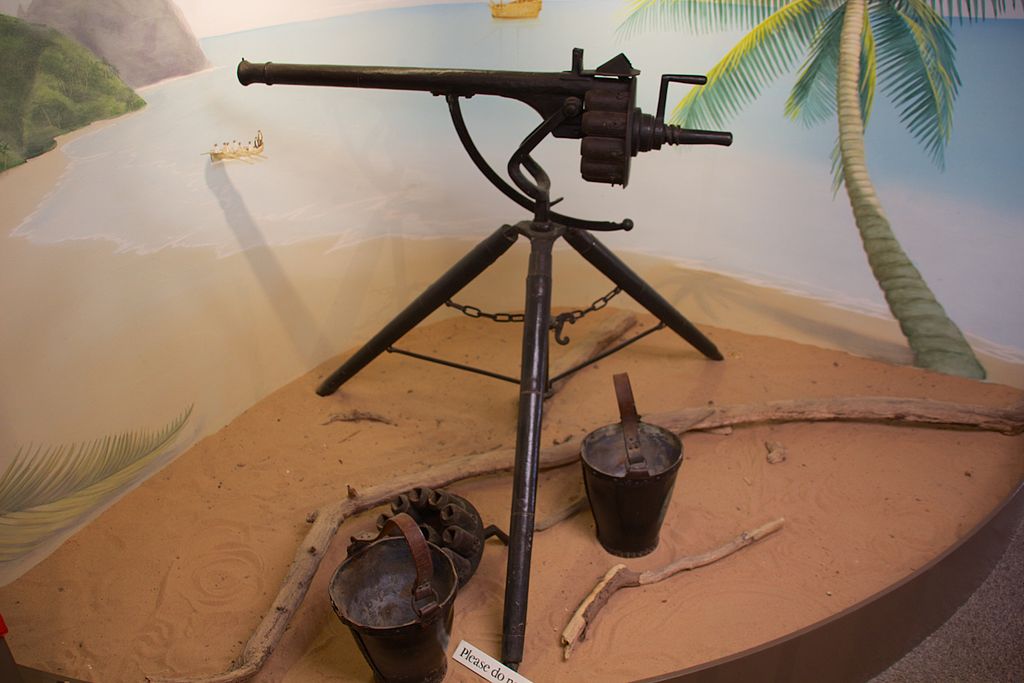
Replica Puckle gun from
Buckler's Hard Maritime Museum
|
Remington-pattern Revolvers
During the period between the widespread adoption of the
revolver, but prior to widespread use of cartridges, a common method of
increasing reload speed was to replace a revolver's entire cylinder with
another pre-loaded one, similar to the Puckle gun. This practice was primarily
done on Remington revolvers, as their cylinders were easily removable and
were held by a cylinder pin, unlike the early Colt revolvers which were
held together by a wedge that went through the cylinder pin.
Confederate revolving cannon
A single example of a 2-inch bore, five-shot revolver
cannon was built and used by the Confederate States of America during the
Siege of Petersburg. It was captured on 27 April 1865 by Union troops and
sent for examination to the United States Military Academy at West Point,
New York..
Article and photo of a rebuilt Puckle Gun.
Gun was rebuilt from two original guns and spare parts.
http://www.wideopenspaces.com/the-puckle-gun-machine-gun-from-300-years-ago/
|
Fire Lance - from Wikipedia
The fire lance (simplified Chinese: ??; traditional Chinese:
??; pinyin: hu? qi?ng) was a very early gunpowder weapon that appeared
in 10th century China during the Jin-Song Wars. It began as a small pyrotechnic
device attached to a spear-like weapon, used to gain a critical shock advantage
right at the start of a melee. As gunpowder improved, the explosive discharge
was increased, and debris or pellets added, giving it some of the effects
of a combination modern flamethrower and shotgun, but with a very short
range (3 meters or less), and only one shot (some were designed for two
shots). In later larger and more powerful fire lances, the lance-point
was discarded, as these versions were too unwieldy to be used in melee.
These are considered to be a proto-gun, the predecessor of the hand cannon,
and the ancestor of all firearms. Fire lances that were too large for a
single man to wield were emplaced upon the ground in a supporting framework;
these can be considered a proto-cannon.
Design
The first fire lances consisted of a tube, usually bamboo,
containing gunpowder and a slow match, strapped to a spear or other polearm
weapon. Once ignited, the gunpowder tube would ideally eject a stream of
flames in the direction of the spearhead. Co-viative projectiles such as
iron pellets or pottery shards were later added to the gunpowder. Upon
firing, the gunpowder charge ejected the projectiles along with the flame.
Metal fire lance barrels appeared around the mid 13th
century and these began to be used independently of the lance itself. The
independent metal barrel was known as an 'eruptor' and became the forerunner
of the hand cannon.
History
The first evidence of fire lances appeared in China in
the year 950 and fire lances were also mentioned in the military text Wujing
Zongyao of 1044. However usage of fire lances in warfare was not mentioned
until 1132 when Song garrisons used them during the Siege of De'an, in
modern-day Anlu, Hubei, when fire lance troops led the vanguard in a sortie
against the Jin dynasty (1115–1234).
In 1163 fire lances were attached to war carts known as
"at-your-desire-carts" used to defend mobile firebomb trebuchets.
In the late 1100s pieces of shrapnel such as porcelain
shards and small iron pellets were added to the gunpowder tube. At some
point fire lances discarded the spearhead altogether and relied solely
on their firepower. |
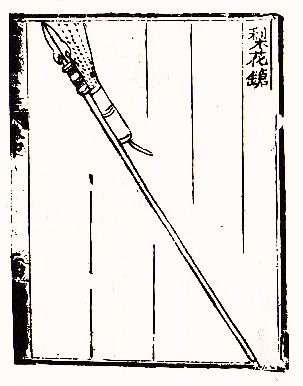
A fire lance as depicted
in the Huolongjing.
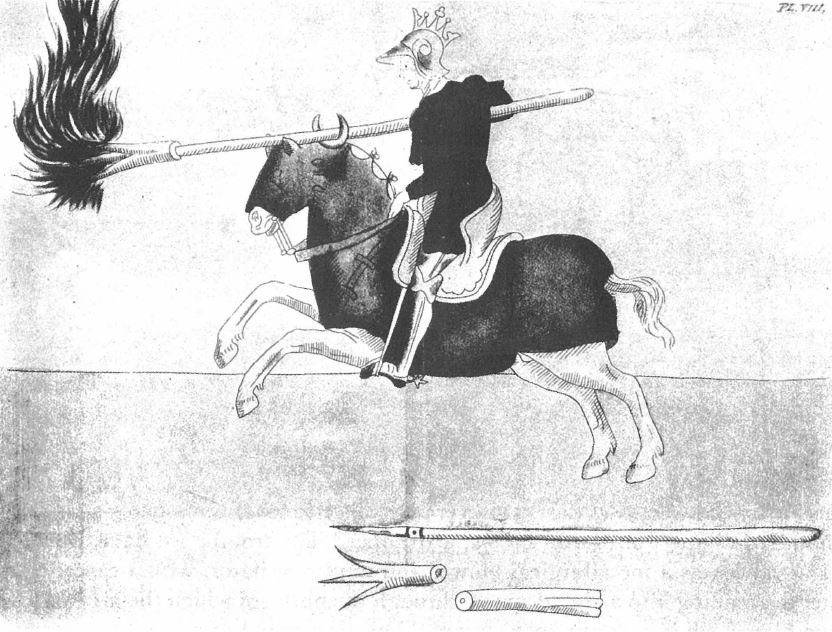
A knight wielding a fire lance ca. 1396. |
By 1232 the Jin were also using fire lances, but with improved
reusable barrels consisting of durable paper material. According to the
History of Jin, these fire lances had a range of roughly three meters:
To make the lance, use chi-huang paper,
sixteen layers of it for the tube, and make it a bit longer than two feet.
Stuff it with willow charcoal,
iron fragments, magnet ends, sulfur,
white arsenic [probably an error that should mean saltpeter], and other
ingredients, and put a fuse to the
end. Each troop has hanging on him
a little iron pot to keep fire [probably hot coals], and when it's time
to do battle, the flames shoot out the
front of the lance more than ten feet,
and when the gunpowder is depleted, the tube isn't destroy.
history of Jin
The Mongol soldiers which they were used against were
apparently disdainful of other Jin weapons, but greatly feared the fire
lance. Jin soldiers also used them in open combat and in one instance,
a contingent of 450 fire lancers routed an entire Mongol encampment
In 1259 a pellet wad that occluded the barrel was recorded
to have been used as a fire lance projectile, making it the first recorded
bullet in history.
By 1276 fire lances had transitioned to metal barrels.
The metal-barreled fire lance began to be used independently
of the lance around the mid to late 13th century. These proto-cannons which
fired co-viative projectiles, known as 'eruptors,' were the forerunners
of the hand cannon.
By 1280 the Middle East had acquired fire lances.
In 1396 European knights took up fire lances as mounted
weapons.
The last recorded usage of fire lances in Europe occurred
during the Storming of Bristol in 1643.
Gallery (click on image to enlarge)

Earliest known
representation of a fire
lance (upper right),
Dunhuang, 950 AD. |
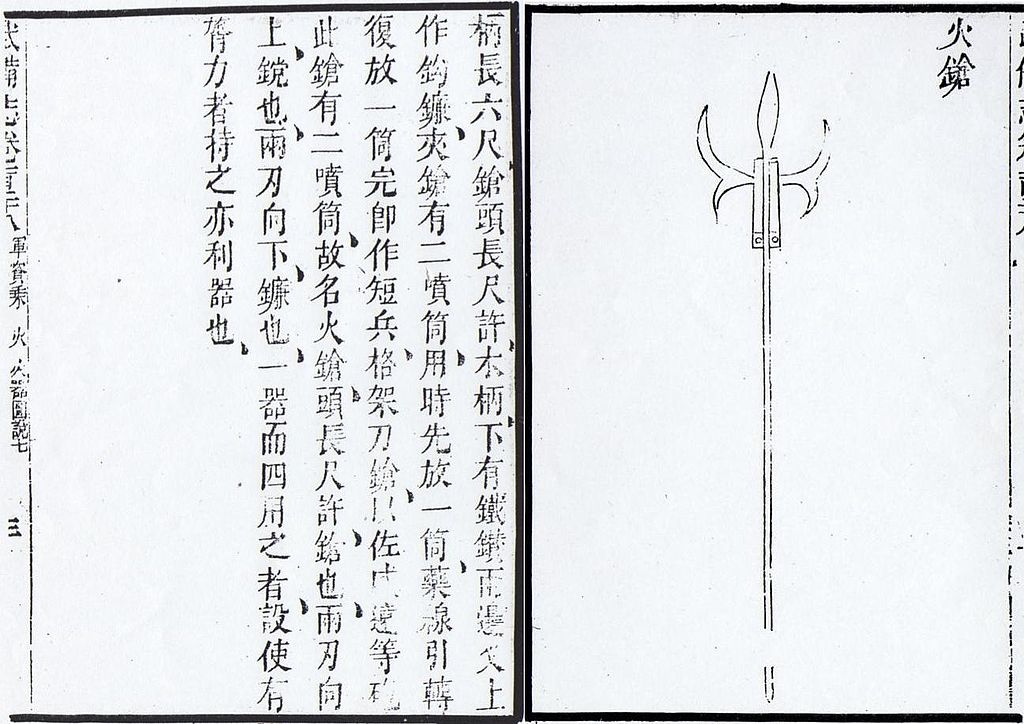
A fire lance from the
Wubei Zhi. |
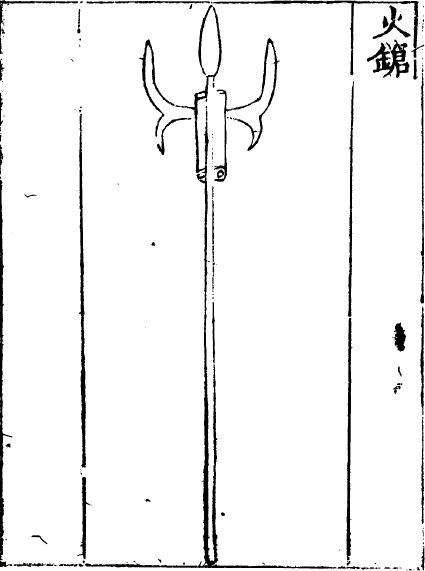
A double barreled fire lance
from the Huolongjing.
supposedly they fired in
succession, and the second
one is lit automatically after
the first barrel finishes
firing. |
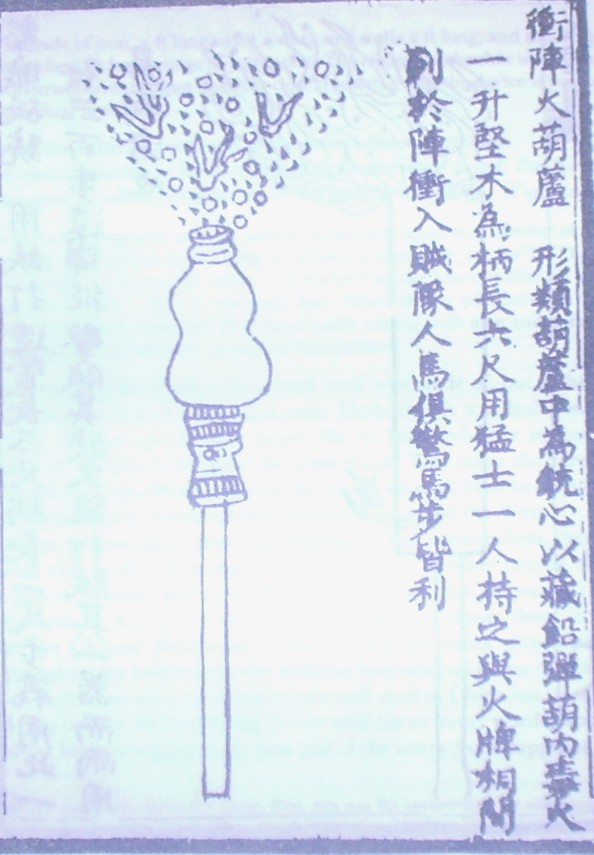
The phalanx-charging
fire-gourd, one of many fire
lance types discharging
lead pellets in the
gunpowder blast, an
illustration from the
Huolongjing.
|
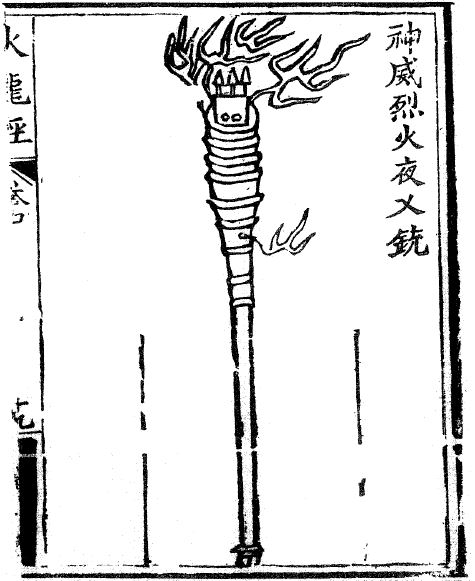
An 'awe-inspiring fierce-fire
yaksha gun' as depicted in the
Huolongjing. |
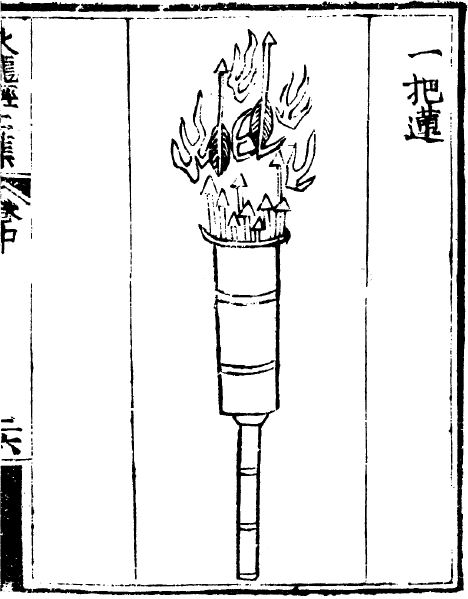
A 'lotus bunch' as depicted
in the Huolongjing.
It is a bamboo tube firing
darts along with flames. |
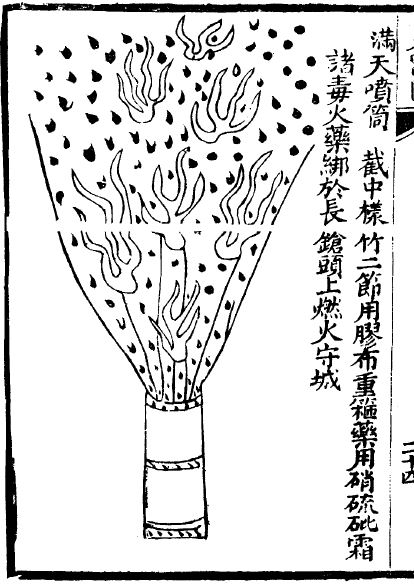
A 'sky-filling spurting-tube'
as depicted in the Huolongjing.
A bamboo tube filled with a
mixture of gunpowder and
porcelain fragments. |
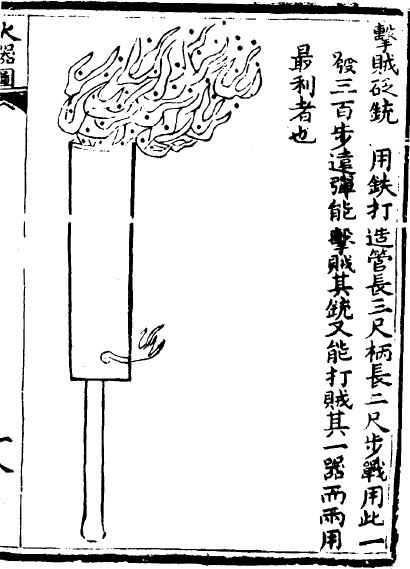
A 'bandit-striking penetrating
gun' as depicted in the
Huolongjing. The first known
metal barreled fire lance,
it throws low nitrate
gunpowder flames along
with coviative missiles.
|
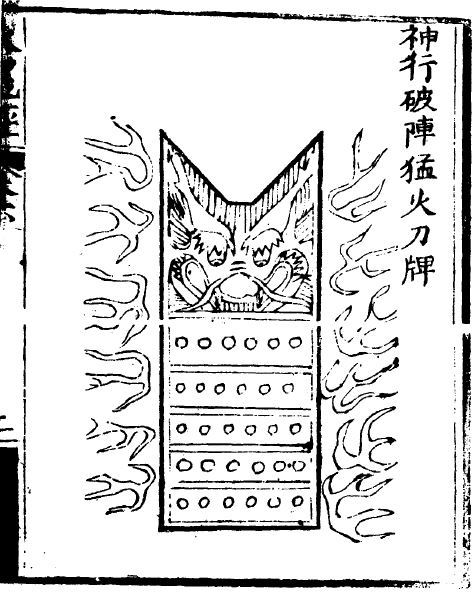
A 'divine moving
phalanx-breaking fierce-fire
sword-shield' as depicted
in the Huolongjing. A mobile
shield fitted with fire lances
used to break enemy formations.
|
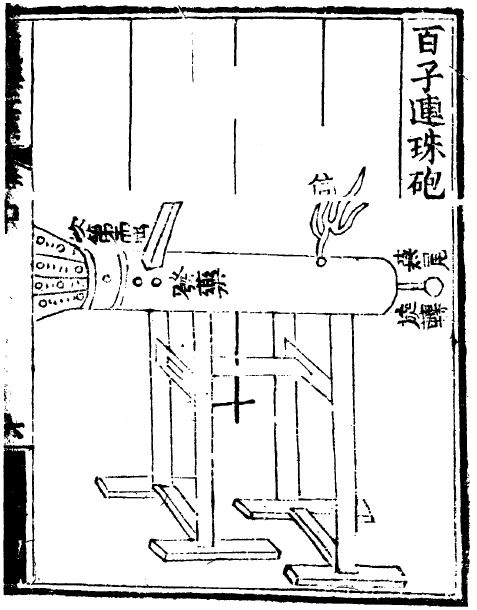
Essentially a fire lance on a
frame, the 'multiple bullets
magazine eruptor' shoots lead
shots, which are loaded in a
magazine and fed into the
barrel when turned around
on its axis.
|
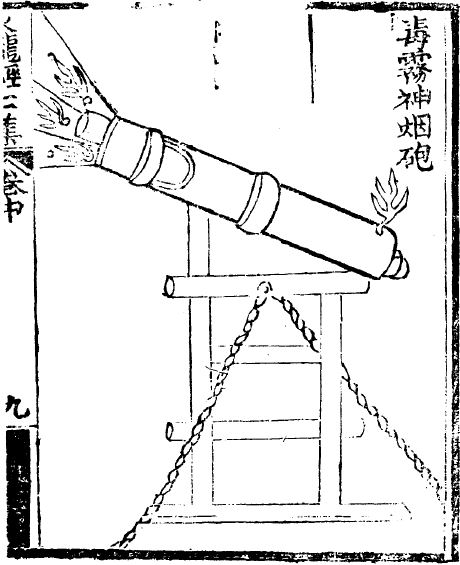
A 'poison fog magic smoke
eruptor' as depicted in the
Huolongjing. Small shells emitting
poisonous smoke are fired. |
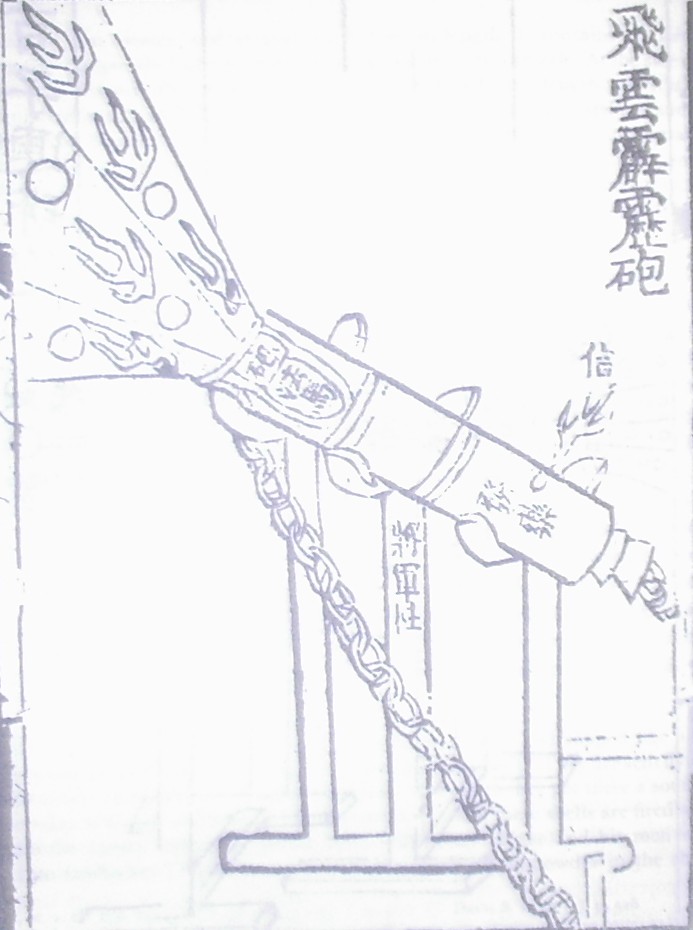
The 'flying-cloud thunderclap-eruptor' cannon from the
Huolongjing. |
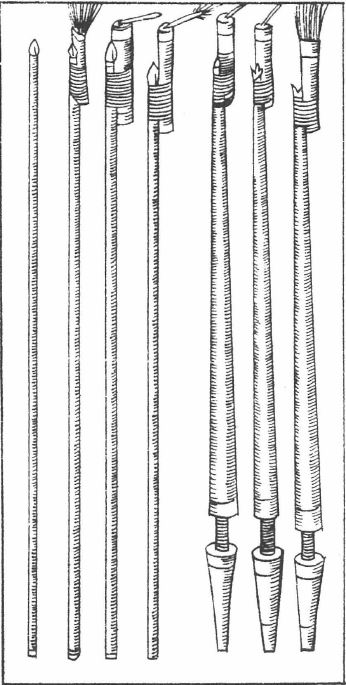
Illustrations of fire lances from
De la pirotechnia by Vannoccio
Biringuccio ca. 1540. |
|
|
|
|
.
All articles submitted to the "Brimstone
Gazette" are the property of the author, used with their expressed permission.
The Brimstone Pistoleros are not
responsible for any accidents which may occur from use of loading
data, firearms information, or recommendations published on the Brimstone
Pistoleros web site. |
|